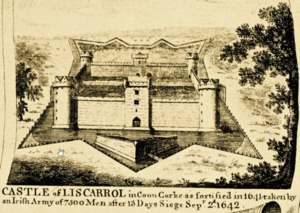Battle of Liscarroll facts for kids
Quick facts for kids Battle of Liscarroll |
|||||||
|---|---|---|---|---|---|---|---|
| Part of the Irish Confederate Wars | |||||||
 Liscarroll Castle, captured by Muskerry the day before the battle |
|||||||
|
|||||||
| Belligerents | |||||||
| Commanders and leaders | |||||||
| Earl of Inchiquin | Garret Barry | ||||||
| Strength | |||||||
| 2,000 foot 400 horse |
7,000 foot 1,500 horse |
||||||
| Casualties and losses | |||||||
| Low | 600 | ||||||
The Battle of Liscarroll was an important fight on September 3, 1642. It happened in northern County Cork, Ireland. This battle was between two main groups: the Irish Confederates and the Royalist troops. It was a part of the Irish Confederate Wars, which started in 1641.
The Confederates were a large group of about 8,500 soldiers. They were led by Garret Barry, an Irish soldier who had fought in the Spanish army. The Royalist forces were much smaller, with about 2,400 soldiers. Their leader was Murrough O'Brien, an Irish Protestant. Even though Inchiquin had fewer soldiers, his strong cavalry (soldiers on horseback) and skilled musketeers (soldiers with guns) helped him win the battle.
What Led to the Battle
The Rebellion began in northern Ireland in October 1641. It was started by Sir Phelim O'Neill. This happened because the King of England was not very strong at the time, just before the English Civil War began. The rebellion quickly spread south, reaching the area of Munster in early 1642.
In January 1642, Catholic nobles in Munster, led by Maurice Roche, 8th Viscount Fermoy, attacked Richard Boyle, 1st Earl of Cork, a Protestant noble, in Youghal. Later, in March and April, the rebels, led by Fermoy and Donough MacCarty, tried to take Cork City. However, Murrough O'Brien fought back and pushed them away.
After this, the Munster rebels chose Garret Barry to lead their army. Barry was an experienced Irish soldier who had served in the Spanish army. In May and June, Barry successfully took Limerick after a siege. The rebels also attacked castles that had been given to English settlers during the Plantation of Munster. This was a time when English settlers were given land in Ireland.
In the summer of 1642, the Munster rebels attacked the castles of Sir Philip Perceval. Muskerry captured Annagh Castle in County Tipperary. In August, he began to attack Liscarroll Castle in northern County Cork. The castle gave up on September 2. The very next day, Inchiquin and his army arrived. They were too late to save the castle, but they were ready to fight.
The Battle Itself
The rebel army was made up of local Catholic lords and their soldiers. Their cavalry was led by Oliver Stephenson. He came from English settlers but joined the rebels because he was Catholic.
The government's army had three English regiments and many local Protestant soldiers. These English regiments had been sent to Ireland in early 1642 to help the army of Sir William St Leger. He was the president of Munster. One of these regiments was led by Charles Vavasour, 1st Baronet, of Killingthorpe. Vavasour commanded the foot soldiers, while Inchiquin was the overall commander and led the cavalry. They chased the Irish rebels when they ran away.
Three of the sons of the 1st Earl of Cork fought in the cavalry during this battle. They were Richard Boyle, Lewis Viscount Boyle of Kinalmeaky, and Roger Boyle. Sadly, Lewis, Viscount Kinalmeaky, was killed in the battle. His older brother then took his title.
Stephenson's horsemen bravely charged Inchiquin's soldiers. This caused some confusion and even led to Inchiquin being captured for a short time. But during the intense fighting, Stephenson was shot and killed. He was shot through the eye-piece of his helmet by Inchiquin's brother. After Stephenson died, the Irish cavalry lost their courage and retreated.
The Irish foot soldiers were not as well trained or disciplined as the Royalists. They could not stand up to the cavalry charge and quickly ran away. This led to a complete defeat for the Irish forces. A big reason for the Irish defeat was the difference in weapons. The Royalists had about 1,500 muskets, while the Irish only had about 500. Most Irish soldiers used pikes, which are long spears.
The day after the battle, Inchiquin and his army were at the castle. Even though they had fewer soldiers, the Royalists defeated the rebels led by General Garret Barry. It is said that Muskerry panicked and ran away, causing others to flee as well. His Protestant friend Barrymore died in September, possibly from injuries he got in the battle.
What Happened After and the Impact
About 600 Irish Confederates were killed in the battle. Many of them were officers, like Stephenson. The local Catholic noble families suffered greatly, for example, 18 members of the Fitzgerald family were killed. They were buried together in a large grave just outside Liscarroll.
Inchiquin also ordered the execution of 50 captured Confederate officers the next morning. The Battle of Liscarroll meant that the central part of County Cork, including Cork City, Bandon, Kinsale, and Youghal, would remain a strong area for the English and Protestants for the rest of the war.

